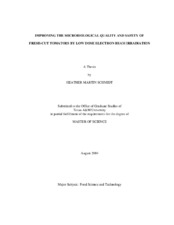Improving the microbiological quality and safety of fresh-cut tomatoes by low dose electron beam irradiation
Abstract
The effect of electron beam irradiation upon microbiological quality and safety of fresh-cut tomatoes was studied. Preliminary studies were conducted to ensure reliability of the rifampicin-resistant strain versus the parent strain of Salmonella serovar Montevideo for use in this study. Growth curve, heat tolerance and lactic acid resistance studies were performed, all of which showed no differences in behavior between the organisms. Fresh tomatoes were obtained from a local supplier and then cut into cubes with stem scars being separated. Both cubes and stem scars were inoculated with a rifampicin- resistant strain of either Salmonella Montevideo or Salmonella Agona, separated into treatment groups and treated by electron beam irradiation at 0.0 kGy (control), 0.7 kGy or 0.95 kGy. The effect of electron beam irradiation was determined for Salmonella, yeast, mold, and lactic acid bacteria (LAB) populations as well as pH on tomato cubes and stem scars over a 15-day storage period at 4??C. Results indicated that while irradiation treatment significantly reduced most microbial populations on tomato samples, there were no differences in the microbial populations between treatments of 0.7 kGy or 0.95 kGy. Irradiation at either dose resulted in a significant reduction of Salmonella Montevideo when compared to the control, with an initial reduction of 1.8 and 2.2 log10 CFU/g on tomatoes for 0.7 kGy and 0.95 kGy, respectively. LAB, yeasts and molds were more resistant to the treatment than Salmonella. Populations present on stem scars and tomato cubes did experience some differences in log reductions, possibly due to the protective effect of the stem scar on microorganisms. However, no differences were detected between the two Salmonella serotypes in response to irradiation treatment. This study indicates that doses of irradiation greater than 1 kGy should be used in fresh-cut tomatoes to eliminate significant populations of pathogens, as well as to ensure the microbial quality of the product. Additional studies also need to be conducted to examine the effects of higher irradiation doses on the sensory qualities of fresh-cut tomatoes.
Citation
Schmidt, Heather Martin (2004). Improving the microbiological quality and safety of fresh-cut tomatoes by low dose electron beam irradiation. Master's thesis, Texas A&M University. Texas A&M University. Available electronically from https : / /hdl .handle .net /1969 .1 /2767.


